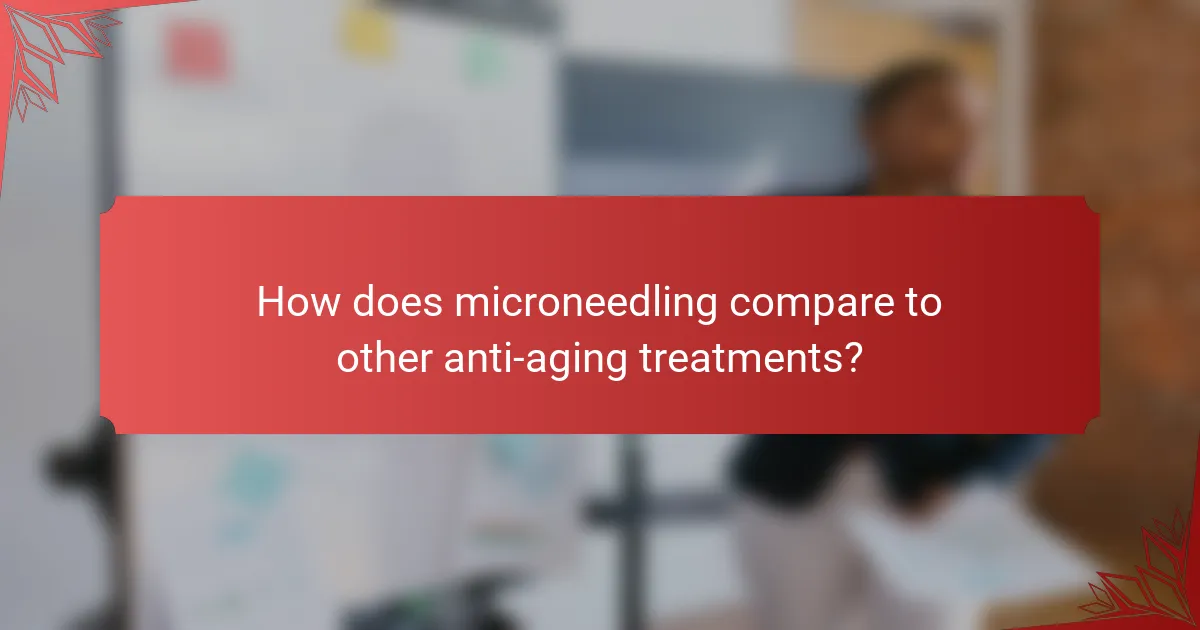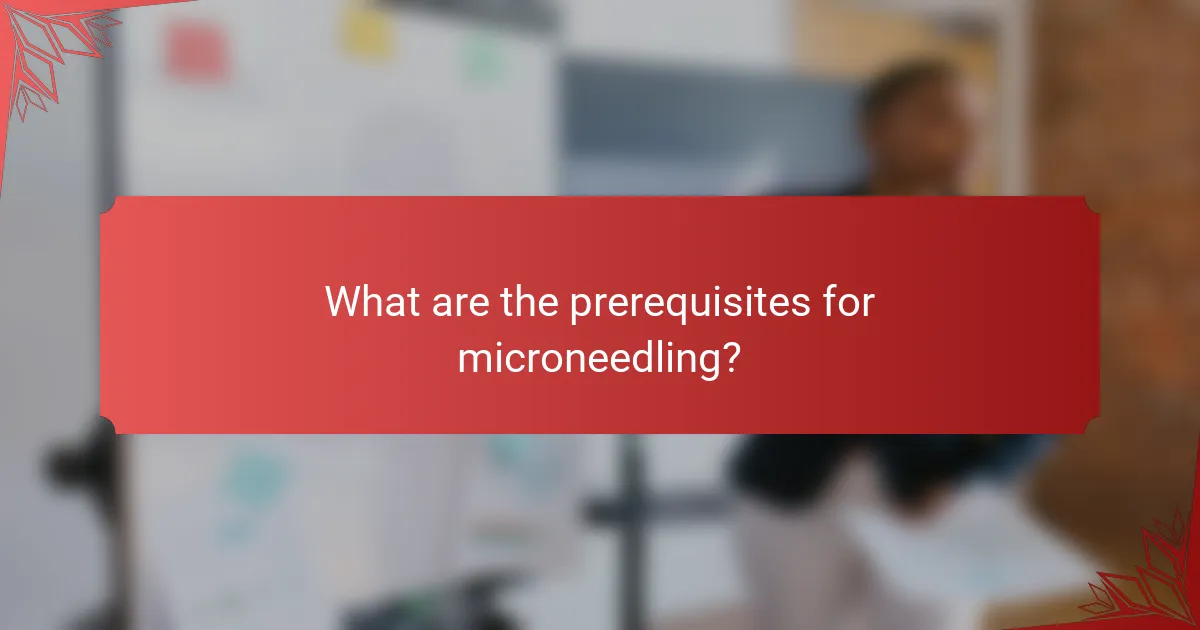Microneedling is a popular anti-aging treatment that utilizes fine needles to create micro-injuries in the skin, stimulating collagen production and enhancing skin rejuvenation. This minimally invasive procedure not only improves skin elasticity but also promotes a youthful glow, making it an effective option for those seeking to address various skin concerns with minimal downtime.

What are the benefits of microneedling for anti-aging?
Microneedling offers several benefits for anti-aging, primarily by promoting skin rejuvenation and enhancing overall appearance. This minimally invasive procedure stimulates the body’s natural healing processes, leading to improved skin elasticity and a youthful glow.
Stimulates collagen production
Microneedling effectively stimulates collagen production, which is crucial for maintaining skin firmness and elasticity. The tiny needles create micro-injuries in the skin, prompting the body to produce more collagen as part of the healing process. Over time, this can lead to noticeably firmer and more resilient skin.
Regular sessions can enhance collagen levels significantly, often resulting in a more youthful appearance. Many practitioners recommend a series of treatments spaced several weeks apart to maximize collagen synthesis.
Improves skin texture
This treatment can significantly improve skin texture by promoting the turnover of skin cells. As new skin cells replace damaged ones, the surface becomes smoother and more even. Microneedling can help reduce rough patches and enhance overall skin clarity.
Patients often report a softer, more refined texture after just a few sessions. Combining microneedling with topical treatments can further enhance these results, as the skin becomes more receptive to nourishing ingredients.
Reduces fine lines and wrinkles
Microneedling is effective in reducing the appearance of fine lines and wrinkles. The increased collagen production helps to plump the skin, filling in lines and creating a smoother surface. This can be particularly beneficial for areas around the eyes and mouth, where wrinkles commonly appear.
Results can vary, but many individuals notice a significant reduction in fine lines after a series of treatments. Maintaining a consistent schedule can help prolong the effects and keep the skin looking youthful.
Enhances product absorption
One of the key advantages of microneedling is its ability to enhance the absorption of topical products. The micro-channels created during the procedure allow serums and creams to penetrate deeper into the skin, maximizing their effectiveness.
Using high-quality, targeted products immediately after treatment can lead to improved results. It’s advisable to consult with a skincare professional to select the best products for your specific skin concerns.
Minimizes scars and stretch marks
Microneedling can also help minimize the appearance of scars and stretch marks by promoting skin regeneration. The treatment encourages the body to heal and remodel the affected areas, which can lead to a reduction in the visibility of scars over time.
For optimal results, multiple sessions may be necessary, especially for older or more pronounced scars. Patients should discuss their specific concerns with a qualified practitioner to determine the best approach for their skin type.

What can I expect during a microneedling session?
During a microneedling session, you can expect a minimally invasive procedure that uses fine needles to create micro-injuries in the skin, promoting collagen production. The session typically lasts about an hour, including preparation and aftercare discussions.
Procedure duration
The duration of a microneedling session usually ranges from 30 to 90 minutes, depending on the treatment area and the specific technique used. This includes time for skin cleansing, numbing, and the actual microneedling process.
For larger areas, such as the face and neck, expect the session to be on the longer side, while smaller areas may require less time. Always consult with your practitioner for a more accurate estimate based on your individual needs.
Discomfort levels
Most patients report mild discomfort during microneedling, often described as a sensation similar to light scratching. A topical anesthetic is typically applied beforehand to minimize pain.
After the procedure, some redness and swelling may occur, resembling a mild sunburn. These effects usually subside within a few days, and over-the-counter pain relief can help manage any lingering discomfort.
Post-treatment care
Post-treatment care is crucial for optimal results. It’s recommended to avoid sun exposure, strenuous exercise, and harsh skincare products for at least 24 hours after the session. Keeping the skin moisturized and using a gentle cleanser is advisable.
Additionally, follow any specific aftercare instructions provided by your practitioner, such as using a soothing serum or avoiding makeup for a short period to allow the skin to heal properly.
Expected results timeline
Results from microneedling typically begin to appear within a few weeks as collagen production increases, with optimal results visible around three to six months post-treatment. The skin may look smoother and more youthful as it heals and regenerates.
For best outcomes, multiple sessions are often recommended, spaced several weeks apart. Discuss your treatment plan with your practitioner to set realistic expectations based on your skin type and goals.

How does microneedling compare to other anti-aging treatments?
Microneedling is a popular anti-aging treatment that uses fine needles to create micro-injuries in the skin, promoting collagen production and skin rejuvenation. Compared to other treatments, it offers unique benefits such as minimal downtime and versatility in addressing various skin concerns.
Microneedling vs. chemical peels
Microneedling and chemical peels both aim to improve skin texture and reduce signs of aging, but they work in different ways. Chemical peels use acidic solutions to exfoliate the skin’s surface, while microneedling stimulates deeper layers through controlled injury. This means microneedling can be more effective for deeper scars and wrinkles.
When considering these treatments, think about your skin type and recovery time. Chemical peels may cause more visible peeling and redness, lasting several days, while microneedling typically results in only minor redness for a day or two.
Microneedling vs. laser therapy
Both microneedling and laser therapy are effective for skin rejuvenation, but they differ in technique and recovery. Laser therapy uses focused light to target specific skin issues, which can lead to more dramatic results but often requires longer recovery times. Microneedling, on the other hand, is less invasive and allows for quicker healing.
Cost is another factor; laser treatments can be significantly more expensive, often ranging from hundreds to over a thousand dollars per session, while microneedling sessions typically cost less. Consider your budget and desired outcomes when choosing between these options.
Microneedling vs. fillers
Microneedling and fillers serve different purposes in anti-aging treatments. Fillers are injectable substances that add volume to specific areas, such as cheeks or lips, providing immediate results. In contrast, microneedling promotes natural collagen production over time, leading to gradual improvements in skin texture and firmness.
If you’re looking for instant volume, fillers may be the better choice, but for long-term skin health and rejuvenation, microneedling is a strong contender. Additionally, fillers generally require maintenance every few months, while microneedling results can last longer with proper skincare.

What are the prerequisites for microneedling?
Before undergoing microneedling, it’s essential to consider your skin type, any existing health conditions, and the necessary consultation steps. These factors ensure the treatment is safe and effective for your individual needs.
Skin type considerations
Different skin types react uniquely to microneedling. For instance, individuals with oily or acne-prone skin may benefit from enhanced collagen production, while those with sensitive or dry skin should approach with caution to avoid irritation. It’s advisable to consult with a professional to determine the best approach for your specific skin type.
Additionally, darker skin tones may have a higher risk of post-inflammatory hyperpigmentation. Therefore, a tailored treatment plan is crucial for minimizing potential side effects.
Health conditions to disclose
Prior to microneedling, disclose any health conditions to your practitioner. Conditions such as eczema, psoriasis, or active infections can affect the treatment’s safety and effectiveness. Individuals with a history of keloid scarring should also inform their provider, as this may influence the decision to proceed.
Furthermore, if you are taking medications like blood thinners or have autoimmune disorders, these factors must be discussed to ensure a safe treatment environment.
Consultation requirements
A thorough consultation is a critical prerequisite for microneedling. During this session, your practitioner will assess your skin, discuss your goals, and review your medical history. This step helps in formulating a personalized treatment plan that aligns with your expectations.
It’s also beneficial to ask questions about the procedure, recovery time, and potential side effects. Understanding these aspects can help you make an informed decision and prepare adequately for the treatment.

What are the costs associated with microneedling in South Africa?
The costs of microneedling in South Africa can vary significantly based on factors such as the clinic’s location, the practitioner’s expertise, and the specific treatment plan. Generally, patients can expect to pay anywhere from a few hundred to over a thousand rand per session.
Average session price
The average price for a microneedling session in South Africa typically ranges from R1,500 to R3,500. This price can fluctuate depending on the clinic’s reputation, the technology used, and any additional treatments included in the session.
It’s advisable to research various clinics and compare prices, as some may offer introductory rates or discounts for first-time clients.
Package deals
Many clinics offer package deals for microneedling, which can provide significant savings. A common package might include three to six sessions at a reduced rate, often ranging from R4,000 to R10,000 total, depending on the number of sessions and any complementary services.
When considering package deals, ensure that the clinic’s credentials and treatment quality are consistent across all sessions to achieve the best results.
Insurance coverage
Microneedling is often considered a cosmetic procedure, which means that most health insurance plans do not cover the costs. However, some patients may find that their insurance offers partial coverage if the treatment is deemed medically necessary for specific skin conditions.
Before proceeding, check with your insurance provider to understand your coverage options and any potential out-of-pocket expenses you may incur.

What are the potential side effects of microneedling?
Microneedling can lead to several side effects, although most are mild and temporary. Common reactions include redness, swelling, and minor discomfort at the treatment site, typically resolving within a few days.
Common side effects
The most frequently reported side effects of microneedling are redness and swelling, similar to a mild sunburn. Patients may also experience slight bruising or tenderness in the treated areas. These effects usually subside within a few days, but some individuals may notice longer-lasting redness.
Less common side effects
Less common side effects include infection, scarring, or changes in skin pigmentation. These risks can be minimized by ensuring the procedure is performed in a sterile environment by a qualified professional. If you notice any unusual symptoms, such as persistent pain or discharge, contact your healthcare provider promptly.
How to minimize side effects
To reduce the likelihood of side effects, follow pre- and post-treatment care instructions carefully. Avoid sun exposure and harsh skincare products for a few days after the procedure. Additionally, consider scheduling your treatment during a time when you can allow your skin to heal without interference from daily activities.
